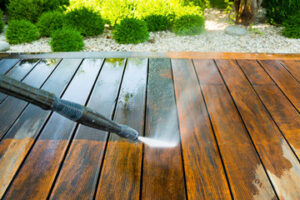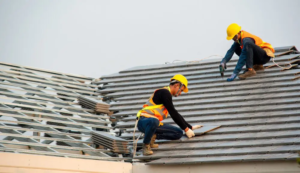Power washing is a great option for sanitizing commercial surfaces. It is also helpful for maintaining cleanliness and improving curb appeal.

Power washing is a method of cleaning that uses high pressure and heated water to blast away dirt, mold, mildew, moss, algae and grime from buildings, fences, sidewalks, driveways, patios and masonry. It is also excellent for removing stuck-on materials like chewing gum from sidewalks and grease stains from garage floors. Visit https://www.certifiedsoftwash.ca/ to learn more.
Power washing is a type of cleaning technique that involves using water spray at high pressure to dislodge and remove dirt, grime, mold, mildew, chewing gum, dust, oil stains, rust and more from outdoor surfaces such as concrete or asphalt driveways, sidewalks, patios, building exteriors, fences, masonry and some vehicles. The high-pressure water blasts away the build-up and debris, leaving the surface clean and looking brand new. Power washing is a popular choice for commercial and industrial cleaning tasks, as well as residential cleaning jobs like decks or patios.
While there are many different types of power washing machines, they all tend to look and function quite similarly. The main difference between a power washer and a regular pressure washer is that a power wash machine includes a heating element to heat up the water for increased cleaning effectiveness, while a normal pressure washer doesn’t.
When used correctly, power washing is a fast and effective way to clean a wide variety of different outdoor surfaces. In most cases, the cleaning process begins by applying a detergent or other cleaning solution to the surface that needs to be cleaned. This helps to break down and loosen the grime, making it easier to remove during the washing stage. Then, the high-pressure water spray is directed at the surface from a range of angles and distances to thoroughly clean it.
The heated water in a power washer also makes it particularly good at getting rid of tough, stuck-on residues like salt, mildew and mold. It’s a great choice for removing grime from outdoor surfaces that are prone to salt and chemical spills, such as concrete or asphalt walkways. And the powerful stream of hot water can even blast away oil stains on a garage floor or driveway.
While there are many benefits of power washing, it’s important to use caution and only hire a professional to handle the job. The high-pressure water can easily damage surfaces if it’s not used properly. And the hot water can damage some materials, such as wood or vinyl siding, if it’s exposed to too much heat for extended periods of time.
Advantages of Power Washing
When you see someone hassling with hoses and cords and a machine on two wheels, chances are they’re power washing. The process involves using a pressure washer that delivers hot water at high-pressure to remove dirt and grime from surfaces like sidewalks, driveways, patios, decks, gutters, roofs, and siding. A cleaning solution is usually added to the water to help break down and dissolve substances that are difficult to remove with plain water.
Power washing is particularly effective for removing tough grime such as grease stains, oil stains, mildew, mold, and algae. It can also help prepare surfaces for repainting, as the removal of loose surface material will allow the new paint to adhere more effectively. It’s important to note that the high-pressure jets of a power washer can damage some surfaces, so it’s best to use this method for hard-surfaced areas that can withstand the powerful water flow and temperature.
One of the biggest advantages of power washing is that it can help extend the lifespan of your building’s exterior. Dirt, grime, and other substances can wear away at surfaces over time, which can lead to expensive repairs later on. Regularly power washing your home or business can remove these substances and prevent them from damaging your property.
Another advantage of power washing is that it can improve your building’s curb appeal. A dirty-looking home or business can make a negative impression on visitors and may deter them from entering. A professional power washing service can get your property looking clean and inviting, which will boost its value if you’re considering selling it in the future.
Power washing is also a good way to protect the health of your family or employees. Mildew, mold, and other substances that grow on the outside of buildings can cause respiratory problems when inhaled. Expert siding power washing services can remove these substances and keep your family healthy. The benefits of power washing are numerous and can help you maintain a beautiful and functional home or business for years to come. It’s important to find the right power washing company near you and hire a professional who knows how to use a high-powered pressure washer without damaging your property.
Types of Surfaces That Can Be Cleaned With Power Washing
Power washing is an effective cleaning method that can remove a wide variety of stubborn dirt and grime from exterior surfaces, including concrete, brick, wood, and paint. It is also a safe and environmentally friendly method for cleaning. Dirt, grime, and other debris can wear away at surfaces over time and cause expensive damage. Using power washing to regularly clean your property can help prevent this damage and extend the lifespan of your building’s exterior materials.
Unlike traditional scrubbing, power washing uses high-pressure jets of water to quickly remove stubborn buildup. The force of the water loosens and dissolves oil, dirt, mildew, and other contaminants from surfaces, making it ideal for cleaning hard-to-reach places such as corners and crevices. This makes it an efficient way to clean driveways, sidewalks, patios, and other outdoor spaces that are difficult to reach with manual scrubbing.
A power washer uses a pump to pressurize water, often above 2,000 pounds per square inch (psi). The force of the water loosens and eliminates impurities from surfaces like concrete, brick, and metal. The process is particularly effective for removing deeply-ingrained stains such as oil and grease, as well as mold, mildew, and algae. It is also a good choice for removing stubborn deposits such as bird droppings and tar from vehicles or buildings.
Power wash can be used to clean a wide range of outdoor surfaces, from concrete and brick to vinyl siding and roof shingles. However, it is important to properly prepare the surface before starting a power wash project. Thoroughly examining the area for cracks and holes is essential, as is covering any delicate plants or outdoor fixtures with plastic sheeting or moving them out of the way. Incorrectly setting the pressure or temperature of the power washer can lead to damage to fragile surfaces, so it is important to use only as much water as necessary and follow the instructions carefully.
There are several key differences between power washing and regular scrubbing that can impact which type of cleaning is appropriate for your home or business. Power washing uses hot water, so it is better suited for tougher stains and more demanding surfaces. However, the heated water can pose a risk to heat-sensitive exteriors such as vinyl and window screens.
Tips for Power Washing
Power washing can help restore and extend the life of surfaces like decks, driveways and siding. It can also help remove stains from concrete, brick and stone. But before you rent or buy a pressure washer, it’s important to know some basics about the equipment. This way, you can use it safely and effectively.
Power Washing Tips
When using a power washer, start on the lowest setting possible to avoid damaging the surface you’re cleaning. If you’re new to power washing, it’s a good idea to practice on something that’s not as valuable or difficult to replace (like your car or garden furniture). Always apply the cleaner and water from the ground up and rinse from the top down without letting the surface dry in between steps. Also, be sure to wear rubber gloves to protect your hands from the harsh chemicals in the detergent.
It’s also a good idea to take a close look at the area you’re cleaning and decide whether it needs power washing or not. If it does, it’s a good idea to prep the surface by taping off any electrical outlets or lights that could be damaged by the high water pressure. You should also tape or cover any spigots that could be turned on by the power washer.
Remember that the pressure from the power washer is intense, so it’s important to keep the nozzle pointed away from people and pets. Also, be careful when moving the machine to avoid tripping or kinking cords and water hoses. Always check the manufacturer’s instructions before operating a power washer, and never point it at another person – it could seriously injure or kill them.
It’s also a good idea to avoid power washing any areas that contain lead paint, or at least have a professional test the paint to make sure it is safe before using a pressure washer on it. The hot water provided by power washing can blast away mildew and mold, but it won’t be able to remove the lead paint from the surface.

